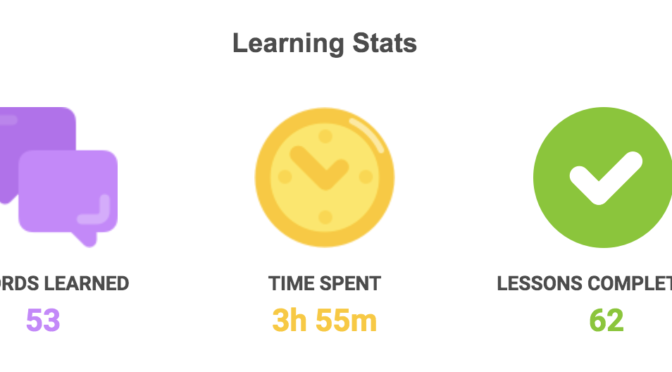Well if you haven’t heard by now, either on this blog or Twitter or your panicky friend, China is undergoing a bit of a crisis here during its Spring Festival holiday. The novel Coronavirus has hit the country particularly hard over the last few days with cases jumping from only 2700 to under 10,000. This has caused some panic for people living outside of China. In China, all I can say is that there are fewer people on the streets but I hear them trampling around my apartment complex.
That being said, how is my Japanese doing? Am I still studying given the current situation? And is my trip still a go at the end of February?
To quickly all of those questions, the answer is “yes”.
My Japanese studies continue yet I haven’t been able to really ramp up my study hours despite the increased time off. I chalk this up to two factors:
First, I’ve stopped listening so much through my headphones. My ears were starting to ache and my headphones aren’t noise cancelling so I often have to turn the volume up quite loud in order for my to be able to hear whatever is going on. Further, I’ve stopped listening on my morning walk opting instead to listen to the birds and to the silence rather than plug my ears with passive listening exercises.
Second, I’m continuing with my Chinese studies which have taken a more intensive approach as of late by way of reading more authentic materials. Those two factors combined with the fact that there are other things I’d like to get done with my extra time off means that my study time has been restricted to only about 80-100 minutes per day.
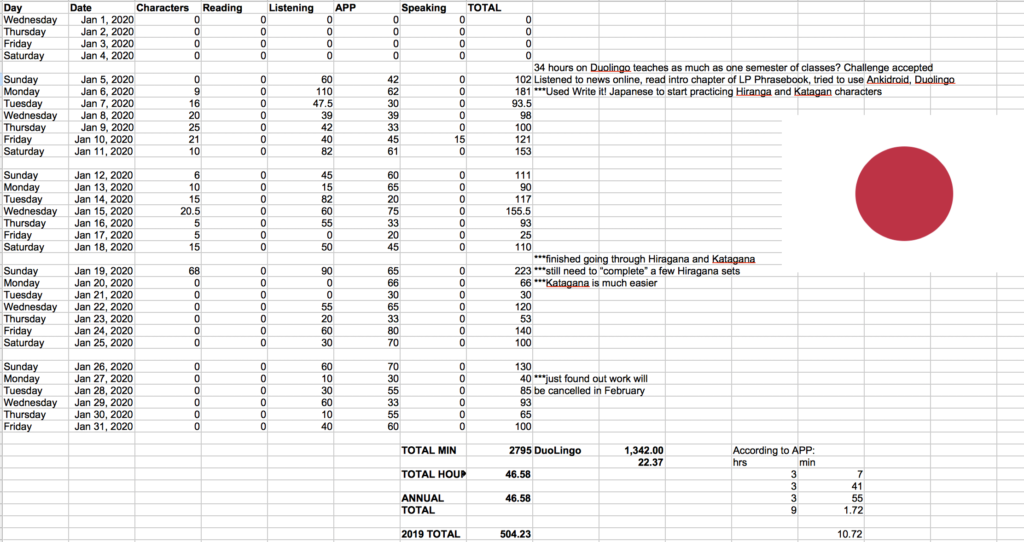
As you can see, I’ve still had about 46.5 contact hours with the language, of those hours about 22 hours were spent using Duolingo in some capacity. You’ll see that I’ve noted the time tracked by the APP itself which is vastly different from the time I keep. There are two reasons: first, as I mentioned before, I start and stop the time based on my clock without regard to APP loading time or deciding which lesson to do. I consider that all “contact time”. Second, I also take some time to read through some of the grammar explanations that I’m not sure the APP counts towards my hourly total.
In any event, 46.5 hours on a new language isn’t bad. But how am I doing with those hours?
The APP says my vocab has expanded quite a bit, and I’ve locked down some simpler words, such as “cat” (neko, ねこ), “dog” (inu, いぬ), “bird” (tori ,とり), “water” (mizu, みず) as well as some more useful phrases such as Hello (konichiwa, こんにちは), Goodbye (sayonara, さようなら), Thank you (arigato, ありがと), Yes/No and a few others. I still fail at trying to pronounce the second part of “Thank You” which is actually arigato gozaimashite (ありがとうございました), likewise with “Nice to meet you” (hajimemashite, はじめまして).
As I mentioned in my previous progress report, I’m still having issues with the changes in pronunciation, notably the cardinal and ordinal numbering, but also words such as “his or hers” as they are said in a sentence rather than just on their own. These difficulties are making me reevaluate just how much I could possibly learn within six weeks.
The good thing about much of exercises I’ve been doing is simply being able to understand the gist of what’s going on. I wrote before about how Japanese uses Kanji characters, those are the characters taken from the Chinese language, but those characters can also be spelled out using Hiragana, the Japanese alphabet. Due to my Chinese studies, I am able to recognize and understand many of the Kanji I see in a sentence, “water” (mizu, 水) is one of them. Other characters for trains, cars and other objects I think use traditional characters rather than the simplified characters I’m studying right now.
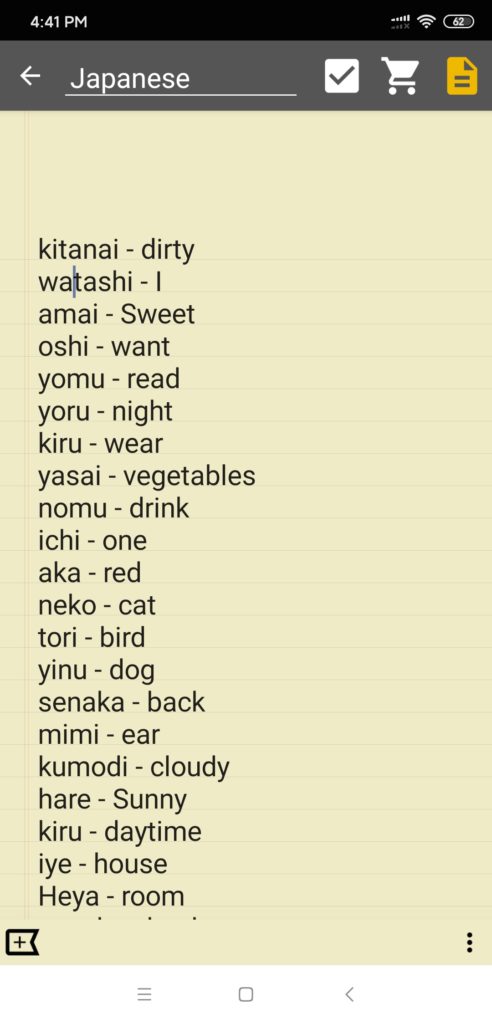
Other than that, I do feel like I’ve plateaud a little bit mainly because I’m only using the Duolingo APP. The APP goes for a very generic approach to the language and covers a lot of material. It does not, however, focus on survival Japanese or other such simplifications of the language. As a result, I am learning things like “cat” and “dog” yet still have trouble remembering how to ask where the toilet is. (トイレはどこですか?)
One of the harder pronunciations I’m having is with the Japanese “r”, which is a cross between an English “r” and “l” but not as hard as the Ukrainian or Russian “r”, so it’s taking some getting used and will no doubt make me sound really bad when I’m there.
As for progress through the APP, you can see below that I have completed Stages 1 and 2 and am now working through Stage 3.
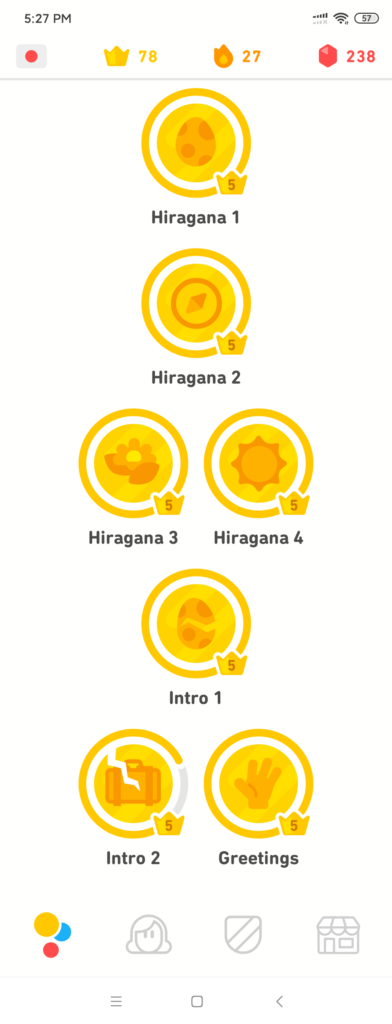
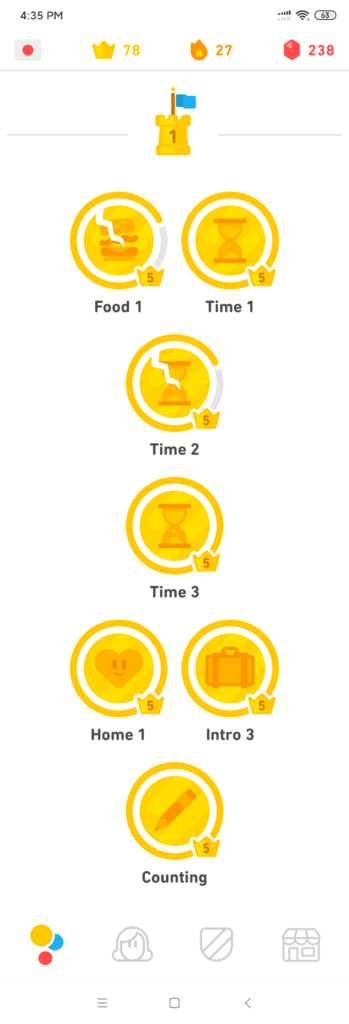

You’ll notice that some of the circles are “broken”, which means I haven’t reviewed those items in a while and need to revisit them in order to maintain my abilities in that area. And it’s true! When I went back to review some of the material, there were some things that I was having trouble remembering.
As you can see from the spreadsheet above, I’m usually spending about an hour per day using the APP. Usually it’s 30-40 minutes in the morning once I wake up (cause it’s easy to click pictures and repeat sounds early in the morning), and then another 25-30 minutes in the evening. (I’m also looking to incorporate AnkiDroid with my studies in an effort to bolster my vocabulary and reinforce the words I have come across already.)
The APP helps track your progress by way of a few metrics. Not only is it the weekly mail out, but also a points system ( denoted by an “XP”), as well as “Crowns” and “lingots”. Rudimentary and pleasing enough, though I often bypass any offers to increase those and instead focus on just using the APP for language learning. One thing that does keep me going is the competition between language learners.
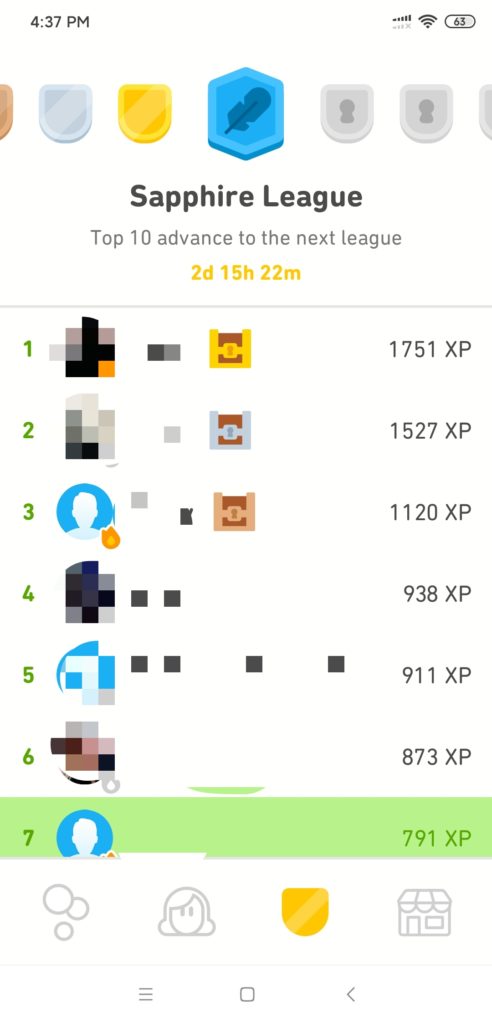
I’ve hit the Sapphire League already, which simply means I’ve consistently ranked high in the top 10-20 language learners. I see what some of the people are doing but binging on the APP for a day and then letting it go for the rest of the week. Those aren’t the people I’m worried about, but the people who have streaks as long as I do. I currently have a 27-day streak going on and consistently hit about 1000 XP points per week. Not bad me thinks.
However, I’m starting to see the limits of the APP especially as we move into the month of departure. Would I be able to get around knowing what I know? Am I able to actually say any of the words? What are the things I actually need to know in order to travel through Japan?
It’s with that in mind that I’m looking to start working through the Lonely Planet phrasebook and possibly some YouTube videos on basic sayings in an effort to get my mouth moving in Japanese fashion. Finally, I am looking at iTalkie.com for a Japanese tutor, possible in another two weeks or so with the idea of practicing conversations and pronunciation. It’s no use until then because my familiarity with the language and vocabulary are still heavily restricted and that would mean a useless lesson for me.
With that, the studies continue with the hope that my trip to Japan is still on at the end of February!
